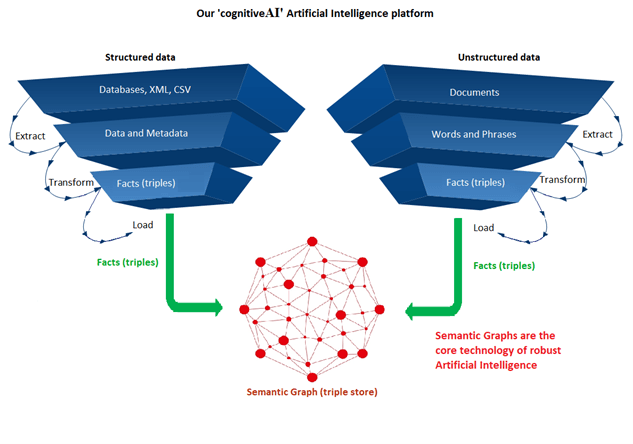Data services to support Enterprise build and leverage AI.
The cognitiveAI Services
The cognitiveAI services are bespoke offerings designed to assist Enterprise to move data into a semantic knowledge base within the cognitiveAI platform to drive business outcomes.
Based on the nature of your data we offer the following three services:
- Data to Knowledge
- Text to Knowledge
- IoT/Edge to Knowledge
Maximize the benefits.
- Make use of all your data.
- Streamline and automate your business processes.
- Build inteligent systems quickly without the needs for PhD level staff.
- Upgrade the business and analytical skills of your staff.
- Target 90%+ AI self-sufficiency within 2 years.
- You do not need a large budget.
Maximize data access.
- 100% W3C standards compliance for re-use and portability.
- Utilise and share your industry standards for knowledge management.
- Access external data using Linked Open Data.
Maximize data integrity.
- Automated data integration.
- Eliminate data duplication.
- One version of the truth.
- Automatically correct or ignore data errors.
- Automatically ignore noisy data.
The cognitiveAI solution rapidly ingests, structures and manages data from multiple data sources (and formats) into a semantically enriched environment.
What is Syntactic Interoperability?
The translation (transformation) of data from one format to another e.g. Oracle format to Microsoft format.
This allows computers to exchange data in a way that is understandable to both senders and receivers
What is Semantic Interoperability?
The semantic annotation of data with metadata that can indicate the meaning of data within a likely context e.g. in the context of Astronomy, the word "Pluto" probably refers to the planet Pluto.
This allows a computer to understand the meaning of the data without being told its meaning by a human.
It's about technology, data, process and Enterprise change.
Data proliferation is overwhelming knowledge workers, causing huge inefficiencies in their ability to organize, query and find the right information.
Where information is created and stored, it is in the form given by the publisher and is stored in a defined format for a particular narrow purpose.
This means that when a person wants to query two or more separate sources, they may have to do two or more queries separately, using different techniques, whilst applying their own limited knowledge, biases and assumptions to their query results. This very human driven process is inefficient and unscalable.
We offer:
• Proof of Concept (no commitment to continue)
• Pilots (commitment to continue)
• Train your in-house team
• Project Management
Data to Knowledge.
We help you convert your structured and semi-structured data into a Semantic Graph.
We use our patented Data Transformation Pre-processor that performs Syntactic Transformation of semi-structured or structured data and inserts it into our Integration Hub.
From there we perform
Semantic Transformation
while loading your data into a
Semantic Graph
of RDF triples and automatically generating an
Ontology.
Text to Knowledge.
This constructs a Semantic Graph from one or more documents and can be used for analytics, semantic search and for other AI purposes.
The Semantic Graph can be beneficial in a range of domains such as medical, legal, intellectual property etc.
The knowledge extraction process uses a range of techniques including Machine Learning , Deep Learning and Natural Language Processing to automatically extract key knowledge from unstructured information such as text.
The annotations are also used to train a model (e.g. for prediction, forecasting etc.) which is then used to predict concepts for subsequently extracted knowledge.
IoT/Edge to Knowledge.
We help you construct a Semantic Graph collected from IoT and Edge devices even if those devices provide data in different formats and structures.
It collects data which has been selectively chosen using user-driven mapping of target requirements.
It automatically performs Syntactic Transformation to structure and mark-up source data into an XML-like document, according to target data requirements.
A patented in-memory virtual store and processing technique is used for
Data Transformation
at the edge and deploys persistent message queuing protocols to provide data to the platform.
Our R & D continues.
Privacy to Knowledge
This constructs a Semantic Graph containing personal information allowing controlled sharing of this information by the owner (e.g. for health record applications, enterprise based social networks etc.). Each user has a Semantic Knowledge Base generated with a personal ontology and for which data security is privately and exclusively driven by the user.
Video to Knowledge
This constructs a Semantic Graph from video streams which are analysed as semi-structured or unstructured data.
Audio to Knowledge
This constructs a Semantic Graph from audio streams which are analysed as semi-structured or unstructured data.



